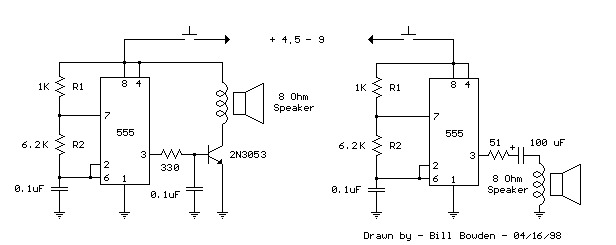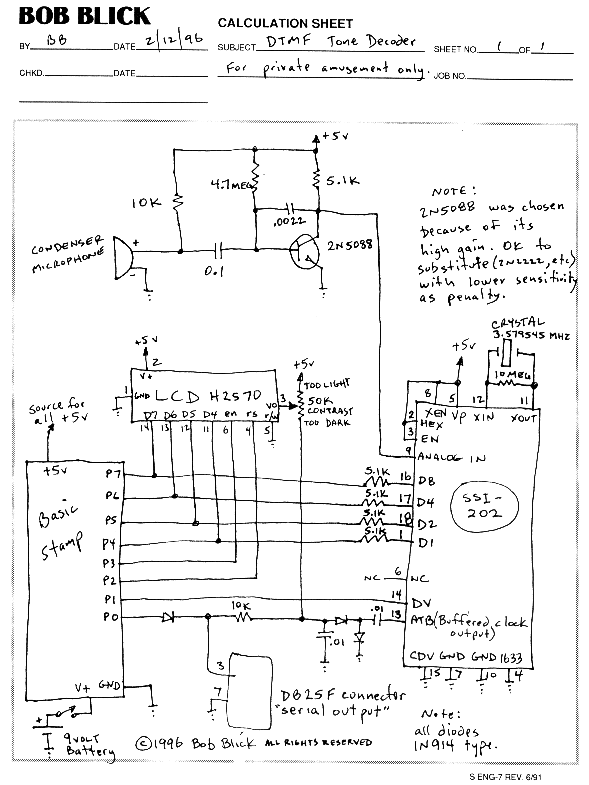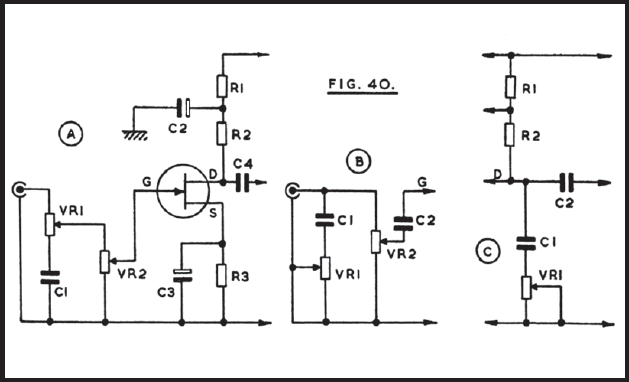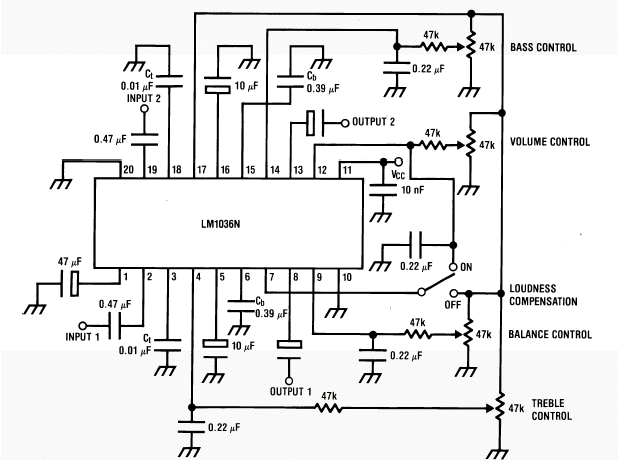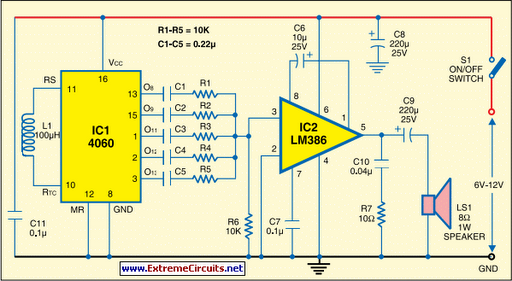
Discrete Sliding Tone (Frequency Ramp) Doorbell
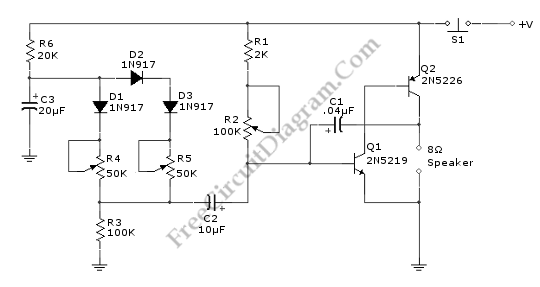
This doorbell circuit generates a low tone that transitions to a higher frequency. The total equivalent resistance connected between the base of Q1 and ground (Rbg), along with coupling capacitor C1, determines the frequency of the audio frequency (AF) oscillator. The resistance (Rbg) is calculated as (R2 R1)R3. The schematic diagram of the circuit illustrates that R2 is used to establish the initial bias condition, which is adjusted to produce a pleasant low starting frequency for the doorbell tone. Diode D1 begins to conduct when capacitor C3 charges through resistor R6 until it reaches the bias voltage level of D1. At this point, Rbg is paralleled by R4 and D1, along with R5-D2-D3. As the voltage across C3 increases, the equivalent resistance of the diodes gradually decreases. This reduction in resistance causes the output tone to slide up in frequency. Two different diode paths are included to extend the linear area of the diode conduction transition slope. With these two paths exhibiting different biases, after the first diode path saturates, the second path allows for a further linear increase at higher voltage levels.
The described doorbell circuit utilizes a combination of resistors, capacitors, and diodes to achieve a unique audio output. The AF oscillator's frequency is primarily influenced by the total resistance Rbg, which is a function of R1, R2, and R3. The initial setting of R2 plays a crucial role in determining the starting frequency of the doorbell tone, ensuring it is both audible and pleasant to the user.
The charging behavior of capacitor C3 is critical in the operation of the circuit. As C3 charges through resistor R6, it reaches a threshold voltage that activates diode D1. Once D1 conducts, it modifies the resistance seen by the oscillator, allowing for a dynamic change in frequency. The interaction between Rbg and the diodes creates a feedback mechanism that results in a frequency sweep as the capacitor charges.
The inclusion of multiple diode paths is a sophisticated design choice that enhances the performance of the circuit. By providing two conduction paths with different biasing conditions, the circuit can maintain a linear transition in frequency even as the voltage increases. This feature not only improves the tonal quality of the output but also ensures that the transition between low and high frequencies is smooth and musically pleasing.
Overall, this doorbell circuit exemplifies a thoughtful integration of electronic components to create an effective and aesthetically pleasing audio output. The careful selection of resistors, capacitors, and diodes allows for a versatile design that can be easily adjusted to meet specific user preferences.This doorbell circuit produces a low tone that will slide up to higher frequency. The equivalent total resistance connected between the base of Q1 and ground (Rbg), and coupling capacitor C1 determines the AF oscillator`s frequency. The resistance (Rbg) is equal to (R2 R1)R3. Here is the schematic diagram of the circuit: The R2 is used to set the initial bias condition, adjusted to produce a pleasant low starting frequency doorbell tone. D1 will start to conduct when Capacitor C3 charge through R6 until it reaches D1 bias voltage level. Then the value of Rbg is paralleled by R4 and D1, and R5-D2-D3, and the values of diode`s equivalent resistance is gradually decreased as the C3 voltage ramp up. This decreasing resistance value make the output tone slides up in frequency. Two different diode path is provided to extend the linear area of diode conduction transition slope. With two path with different biases, after the single diode path has saturated, the second path provide further linear increase at higher voltage level.
🔗 External reference
The described doorbell circuit utilizes a combination of resistors, capacitors, and diodes to achieve a unique audio output. The AF oscillator's frequency is primarily influenced by the total resistance Rbg, which is a function of R1, R2, and R3. The initial setting of R2 plays a crucial role in determining the starting frequency of the doorbell tone, ensuring it is both audible and pleasant to the user.
The charging behavior of capacitor C3 is critical in the operation of the circuit. As C3 charges through resistor R6, it reaches a threshold voltage that activates diode D1. Once D1 conducts, it modifies the resistance seen by the oscillator, allowing for a dynamic change in frequency. The interaction between Rbg and the diodes creates a feedback mechanism that results in a frequency sweep as the capacitor charges.
The inclusion of multiple diode paths is a sophisticated design choice that enhances the performance of the circuit. By providing two conduction paths with different biasing conditions, the circuit can maintain a linear transition in frequency even as the voltage increases. This feature not only improves the tonal quality of the output but also ensures that the transition between low and high frequencies is smooth and musically pleasing.
Overall, this doorbell circuit exemplifies a thoughtful integration of electronic components to create an effective and aesthetically pleasing audio output. The careful selection of resistors, capacitors, and diodes allows for a versatile design that can be easily adjusted to meet specific user preferences.This doorbell circuit produces a low tone that will slide up to higher frequency. The equivalent total resistance connected between the base of Q1 and ground (Rbg), and coupling capacitor C1 determines the AF oscillator`s frequency. The resistance (Rbg) is equal to (R2 R1)R3. Here is the schematic diagram of the circuit: The R2 is used to set the initial bias condition, adjusted to produce a pleasant low starting frequency doorbell tone. D1 will start to conduct when Capacitor C3 charge through R6 until it reaches D1 bias voltage level. Then the value of Rbg is paralleled by R4 and D1, and R5-D2-D3, and the values of diode`s equivalent resistance is gradually decreased as the C3 voltage ramp up. This decreasing resistance value make the output tone slides up in frequency. Two different diode path is provided to extend the linear area of diode conduction transition slope. With two path with different biases, after the single diode path has saturated, the second path provide further linear increase at higher voltage level.
🔗 External reference
